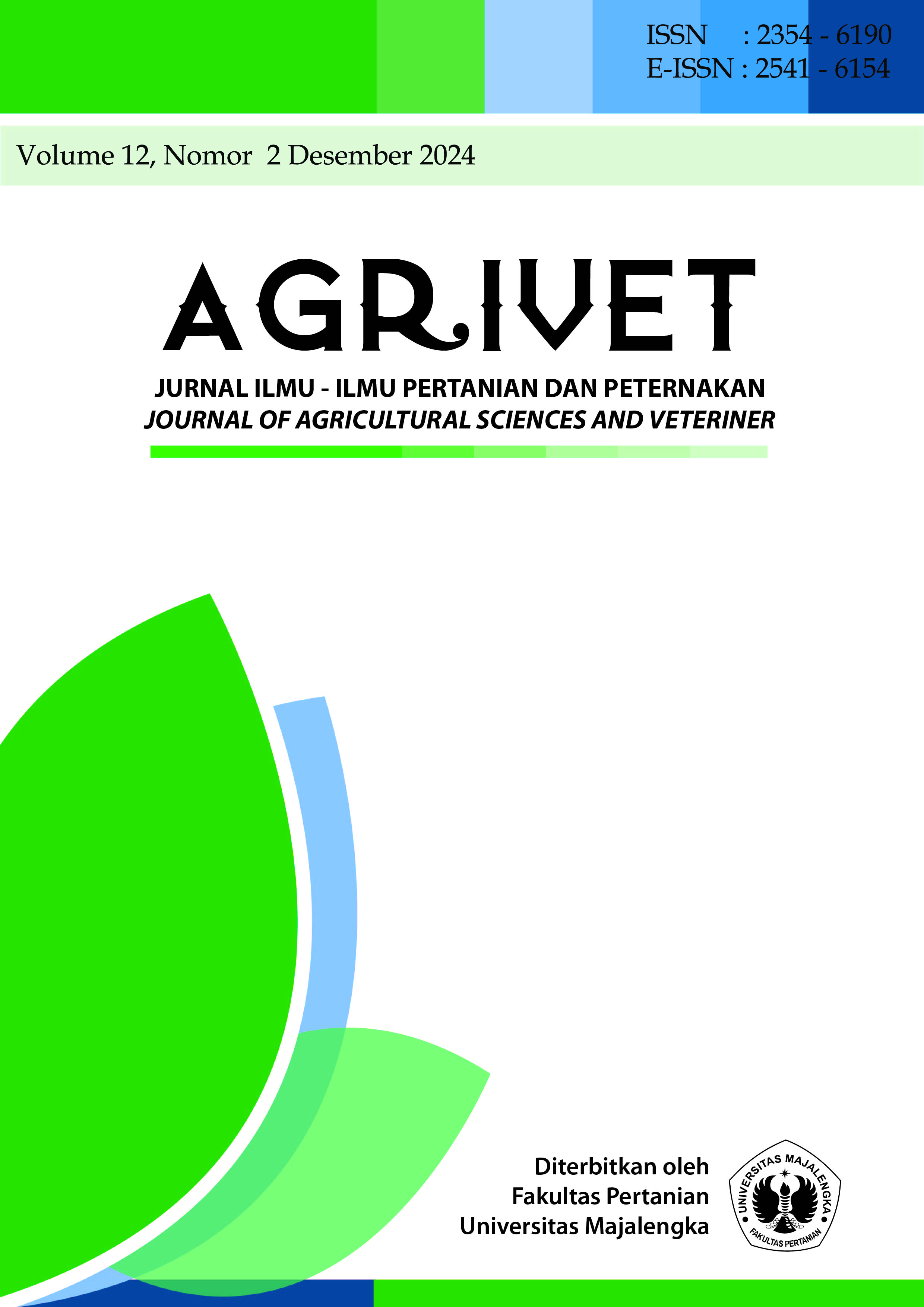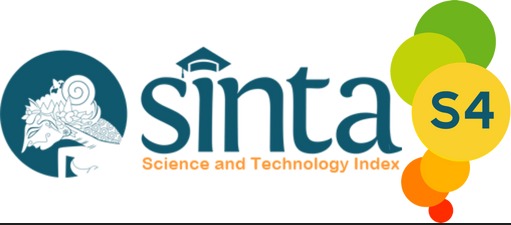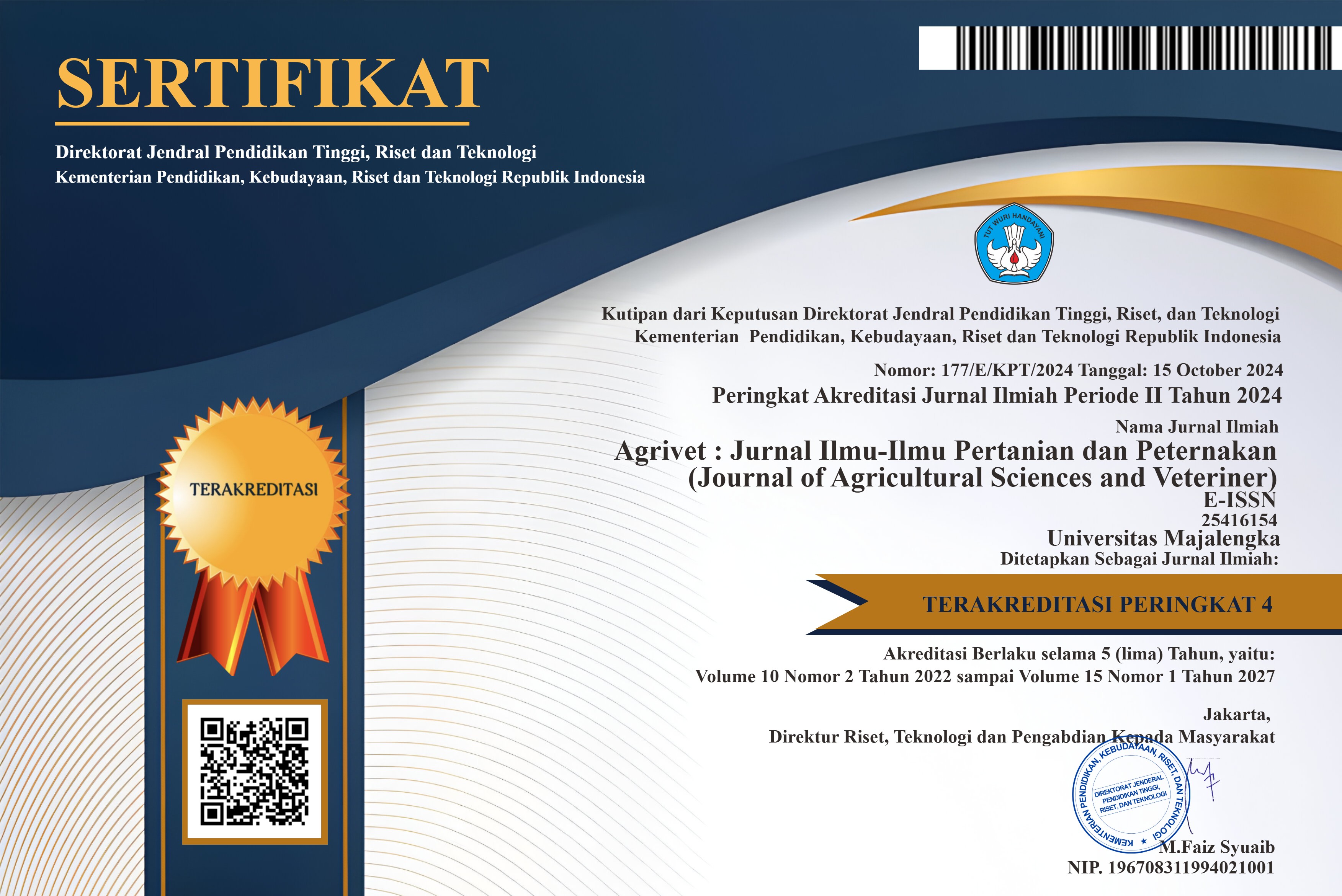Mengeksplorasi respon genotipe jagung calon hibrida umur genjah pada tekanan kepadatan populasi
DOI:
https://doi.org/10.31949/agrivet.v12i2.10359Abstract
Research was conducted in an Experimental Farm to determine the response of several early maturing hybrid maize genotypes to population density pressure in Bone District, South Sulawesi Province, Indonesia. The experiment used a Split Plot Design consisting of main and subplots. The main plot consisted of four maize genotypes; ST201359 (Gt1), ST201312 (Gt2), Bima 7 (Gt3), Bima 3 (Gt4), and as subplots population density of 83,333 plants/ha (Pa), and 100,000 plants/ha (Pb). The two factors tested resulted in 8 treatment combinations, each combination was repeated three times as a block so that 24 experimental units were obtained. The results showed that maize genotypes Gt4, Gt1, Gt2, and Gt3, respectively, gave significant effects on almost all observed variables; plant height, flowering age, leaf area index, harvest age of maize genotypes < 90 hst, cob length, cob diameter, number of seeds per cob, yield per plot and yield per hectare. Population density pressure of 100,000 plants/ha as a single factor gave a significant effect on some of the observed variables namely; leaf area index, cob length, yield per plot, and yield per hectare increased with a population of 100,000 plants/ha. In this study, there was an interaction between maize genotype Gt4 (Bima 3) and population density of 100,000 plants/ha that significantly affected the variable of maize cob length.
Keywords:
Early maturing, Maize genotypes, Population densityDownloads
References
Abuzar, M.R, Sadozai, G.U., Baloch, M.S., Baloch, A.A., Shah, I.H., Javaid, T. and Hussain, N. 2011. Effect of Plant Population Densities on the Yield of Maize. Journal of Animal and Plant Sciences, 21, 692-965.
Al-Naggar, A.M.M., R.A. Shabana, M.M.M. Atta, T.H. Al-Khalil. Maize response to
elevated plant density combined with lowered N-fertilizer rate is a genotype
dependent. The Crop Journal 2 (2015): 96-109.
Brekke, B., Edwards, J., Knapp, A., 2011. Selection and adaptation to high plant density
in the Iowa stiff stalk synthetic maize (Zea mays L.) population. Crop Sci. 51,
–1972.
Darmawan, A., & Suhartati, S. (2018). Pengaruh umur panen dan jarak tanam terhadap hasil dan kualitas biji jagung hibrida NK 731. Jurnal Agron Indonesia, 46(2), 147-154.
Direktorat Jendral Ketahanan Pangan Kementerian Pertanian Republik Indonesia. 2022. 2022, Kementan Targetkan Produksi Jagung 23,1 Juta Ton.
https://www.agrofarm.co.id/2022/02/44331/ diakses 28 September 2023.
Duvick, D.N. Genetic progress in yield of United States maize (Zea mays L.). Maydica
, 50: 193–202.
Duvick, D.N. The contribution of breeding to yield advances in maize (Zea mays L.). Adv. Agron. 2005, 86: 83–145.
Emam, Y. 2001. Sensitivity of grain yield components to plant population density in non-prolific maize (Zea mays) hybrids. Indian J. Agric. Sci. 71(6): 367-370.
Hashemi, A. M., Herbert, S. J. and Putnam, D. H. 2005. Yield response of corn to crowding stress. Agron. J. 97: 839 – 846.
Ipsilandis, C.G.; Vafias, B.N. Plant density effects on grain yield per plant in maize:
Breeding implications. Asian J. Plant Sci. 2005, 4, 31–39.
Ipsilandis, C.G.; Vafias, B.N. Plant density effects on grain yield per plant in maize:
Breeding implications. Asian J. Plant Sci. 2005, 4, 31–39.
Kamruzzaman, M., Haque, M. E., & Islam, M. S. 2022. Effect of plant population density on growth, yield, and quality of maize (Zea mays L.) under rainfed conditions. Journal of Agricultural Science, 18(2), 162-172.
Kasryno Faisal, Pasandaran Effendi, Suyamto dan Adnyana Made O. 2016. Gambaran
Umum Ekonomi Jagung Indonesia. http://balitsereal.litbang.pertanian.go.id/wp-
content/uploads/2016/11/satu.pdf diakses 28 September 2023.
Kementerian Koordinator (Menko) Bidang Perekonomian Republik Indonesia. 2022. Pemerintah Dorong Peningkatan Produksi Jagung Nasional, Melalui Intensifikasi dan Ekstensifikasi, Khususnya Perluasan Lahan Baru, Untuk Memenuhi Kebutuhan Nasional dan Ekspor. https://www.ekon.go.id/publikasi/detail/4403/pemerintah-dorong-peningkatan-produksi-jagung-nasional-melalui-intensifikasi-dan-ekstensifikasi-khususnya-perluasan-lahan-baru-untuk-memenuhi-kebutuhan-nasional-dan-ekspor diakses 28 September 2023.
Konuskan, O. 2000. Effects of Plant Density on Yield and Yield Related Characters of Some Maize Hybrids Grown in Hatay Conditions as Second Crop. Mount Kenya University, Thika, Kenya.
Malaviarachchi, M.A.P.W.K, Karunarathne H., and Jayawardane, S.N. 2016. Influence of plant density on yield of hybrid maize (Zea mays L.) under supplementary irrigation. Journal of Agricultural Sciences – Sri Lanka. 3(2):58.
Ndzimandze, S., Mabuza, M. and Tana, T. 2019. Effect of Plant Density on Growth and Yield of Maize [Zea mays (L.)] Hybrids at Luyengo, Middleveld of Eswatini. Asian Plant Research Journal. 3(3-4): 1-9.
Novacek, M. J., Mason, S. C., Galusha, T. D. and Yaseen, M. 2013. Twin rows minimally impact irrigated maize yield, morphology, and lodging. Agro. J. 105: 258 – 276.
Ren, X., Sun, D., Wang, Q., 2016. Modeling the effects of plant density on maize
productivity and water balance in the loess plateau of China. Agric. Water Manag.
, 40 – 48.
Rivadossi, A., G. Zucchelli, F.M. Garlaschi, and R.C. Jennings. 2004. Light absorption by the chlorophyll a-b complex of photosystem II in a leaf with special references to LHCII. Photochemistry and Photobiology 8:492-498.
Seyed Sharifi, R., M. Sedghi and A. Gholipouri, 2009. Effect of population density on yield and yield attributes of maize hybrids. Research J. Biological Sci., 4(4): 375- 379.
Shi, Y., Qin, Y., Sun, Y., Zhu, P., Wang, J., 2008. Researches on the relationships
between soil moisture and maize planting densities as well as yields. Chin. J. Soil
Sci. 39, 792–796.
Stranger, T. F. and Laue, J. G. 2006. Optimum plant population of Bt and non–Bt corn in Wisconsin. Agron. J. 98: 914 – 921.
Sulaiman, M., Ismail, M., & Abdullah, R. 2023. Effects of plant density on gibberellin production and yield of maize (Zea mays L.) under rainfed conditions. Journal of Agronomy.
United States Departement of Agriculture. 2022. Amerika Serikat, Produsen Jagung Terbesar Dunia pada 2022. https://dataindonesia.id/sektor-riil/detail/amerika-serikat-produsen-jagung-terbesar-dunia-pada-2022 diakses 28 September 2023.
Zamir M. S. I., A. H. Ahmad, H. M. R. Javeed and T. Latif (2011). Growth and yield behavior of two maize hybrids (Zea mays L.) towards different plant spacing. Cercetări Agronomice în Moldova. 14(2): 33-40.
Zamir M. S. I., A. H. Ahmad, H. M. R. Javeed and T. Latif. 2011. Growth and yield behavior of two maize hybrids (Zea mays L.) towards different plant spacing. Cercetări Agronomice în Moldova. 14(2): 33-40.
Zhang, J., S. Dong, K. Wang, C. Hu and P. Liu, 2006. Effects of shading on the growth, development, and grain yield of summer maize. Ying Yong Sheng Tai Xue Bao., 17(4): 657-662 (Chinese).
Zhirui Y., Yibo C., Yiting S., Feng Q., Caifu J., Shuhua Y. 2023. Genetic and molecular exploration of maize environmental stress resilience. Toward sustainable agriculture. Molecular Plant. 16(10): 1496 -1517.
Published
How to Cite
Issue
Section
License
Copyright (c) 2024 Sulkifli, Hafizhah Al-Amanah, Eka Sudartik, Andi Cakra Yusuf, Hasriliandi Halim

This work is licensed under a Creative Commons Attribution-ShareAlike 4.0 International License.
An author who publishes in the Jurnal Agrivet agrees to the following terms:
- Author retains the copyright and grants the journal the right of first publication of the work simultaneously licensed under the Creative Commons Attribution-ShareAlike 4.0 License that allows others to share the work with an acknowledgment of the work's authorship and initial publication in this journal
- The author is able to enter into separate, additional contractual arrangements for the non-exclusive distribution of the journal's published version of the work (e.g., post it to an institutional repository or publish it in a book) with the acknowledgment of its initial publication in this journal.
- The author is permitted and encouraged to post his/her work online (e.g., in institutional repositories or on their website) prior to and during the submission process, as it can lead to productive exchanges, as well as earlier and greater citation of the published work












